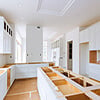How To Measure Kitchen Cabinets Perfectly in 7 Steps
The best kitchen designs start with accurate kitchen measurements. Whether you're planning to DIY or you're working with a contractor on installing new kitchen cabinets, the success of your kitchen remodel hinges on a thorough floor plan. From recording the center point of big appliances to marking obstructions, there's a lot to account for before you can start designing your dream kitchen.
To help save you some time and confusion, we've created a step-by-step guide on how to measure kitchen cabinets for your new layout. It walks through instructions from start to finish, with expert tips to help you along the way.
Download the PDF below for printable instructions and a sample grid layout to get started on measuring your kitchen for new kitchen cabinets.
1. Draw Your Floor Plan | 2. Record Your Horizontal Measurements | 3. Record Your Vertical Measurements | 4. Mark Obstructions | 5. Place Appliances and Utilities | 6. Choose Your Kitchen Layout | 7. Shop for Kitchen Cabinets | How To Measure Kitchen Cabinets FAQs
1. Draw Your Floor Plan
To carefully configure the dimensions of your kitchen, start with a floor plan. Sketch your kitchen layout using grid paper.
Be sure to mark the exact locations of any of the following:
- Doors
- Windows
- Electrical outlets
- Light switches
- Gas lines
- Water lines
- Drain lines
- Hood vents
- Heating and air vents
Tip: Use this key to label openings and obstructions on your kitchen floor plan.

The first rough draft of your floor plan should look similar to the example below. While it doesn't need to be exactly to scale, your sketch should be neat, clear, and accurate.
Tip: Take photos of your kitchen so you can compare before and after pictures of your kitchen makeover.

2. Record Your Horizontal Measurements
Once you have the first draft of your floor plan, it's time to measure the length of your space. Be sure to use inches when you record your measurements. For example, since 3 feet and 6 inches equal 42 inches, you would record 42 inches for that dimension.
How to Measure Full Wall Lengths
Accurate wall measurements will ensure your new cabinets and appliances fit perfectly into your updated kitchen layout. To measure the length of your walls:
- Start from an adjoining corner of the wall and work clockwise, taking horizontal measurements of the wall at 36-inch height.
- Measure from one edge of the wall to the other, skipping over any windows, appliances, or fixtures.
- Label each of the walls with a number for easy reference.
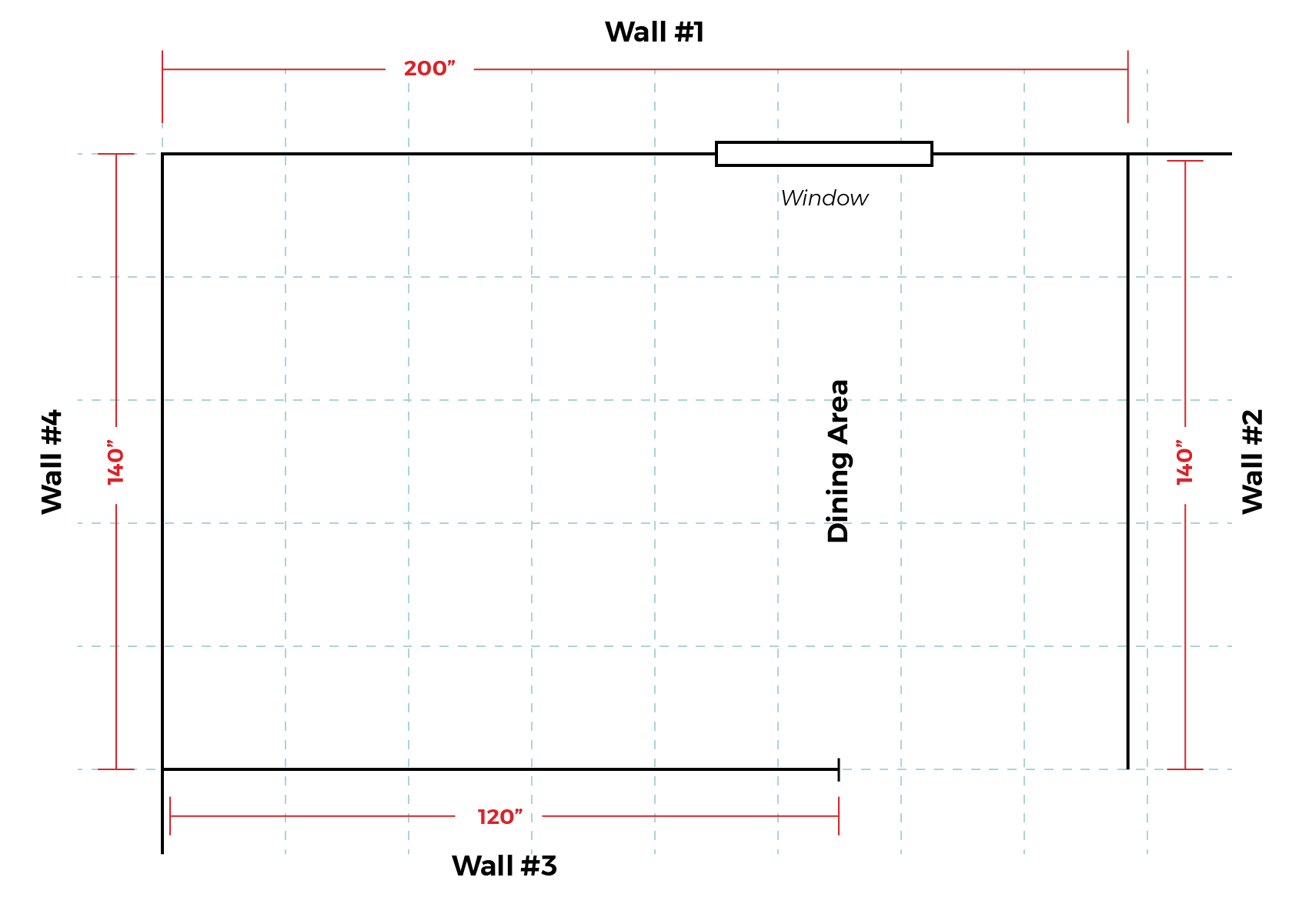
How To Measure Openings and Small Wall Sections
After you've recorded the entire wall lengths, measure and record the wall in smaller segments - for example, from a corner of the wall to the outside trim of a window.
- Measure all openings, such as windows or doors, from one outside trim edge to the other outside trim edge. Any trim or molding around it should be part of the measurement.
- Number each opening so it's easy to reference later.
Tip: Be sure to double-check your kitchen measurements when you're done to ensure accuracy.
3. Record Your Vertical Measurements
Knowing the height of your space will help you decide how high or low you should install your wall cabinets. Typically, upper cabinets hang about 18 inches above your countertop.
Measure and record these heights into your floor plan:
- Inches from the floor to the windowsill
- Inches from the windowsill to the top of the window
- Inches from the top of the window to the ceiling.
Next, measure from the floor to ceiling in at least three different spots of your kitchen. This is especially important in older homes since ceiling heights can vary.
Tip: If you have a recessed ceiling or soffit, measure the height and depth and make a note on your floor plan.
4. Mark Obstructions
Radiators, pipes, or vents are common obstructions that should be recorded, as they usually can't be removed when it comes time to install your new cabinets. Use the provided key and carefully label any and all obstructions.
Tip: A common obstruction to label is a heat vent in the base area of your kitchen cabinets.
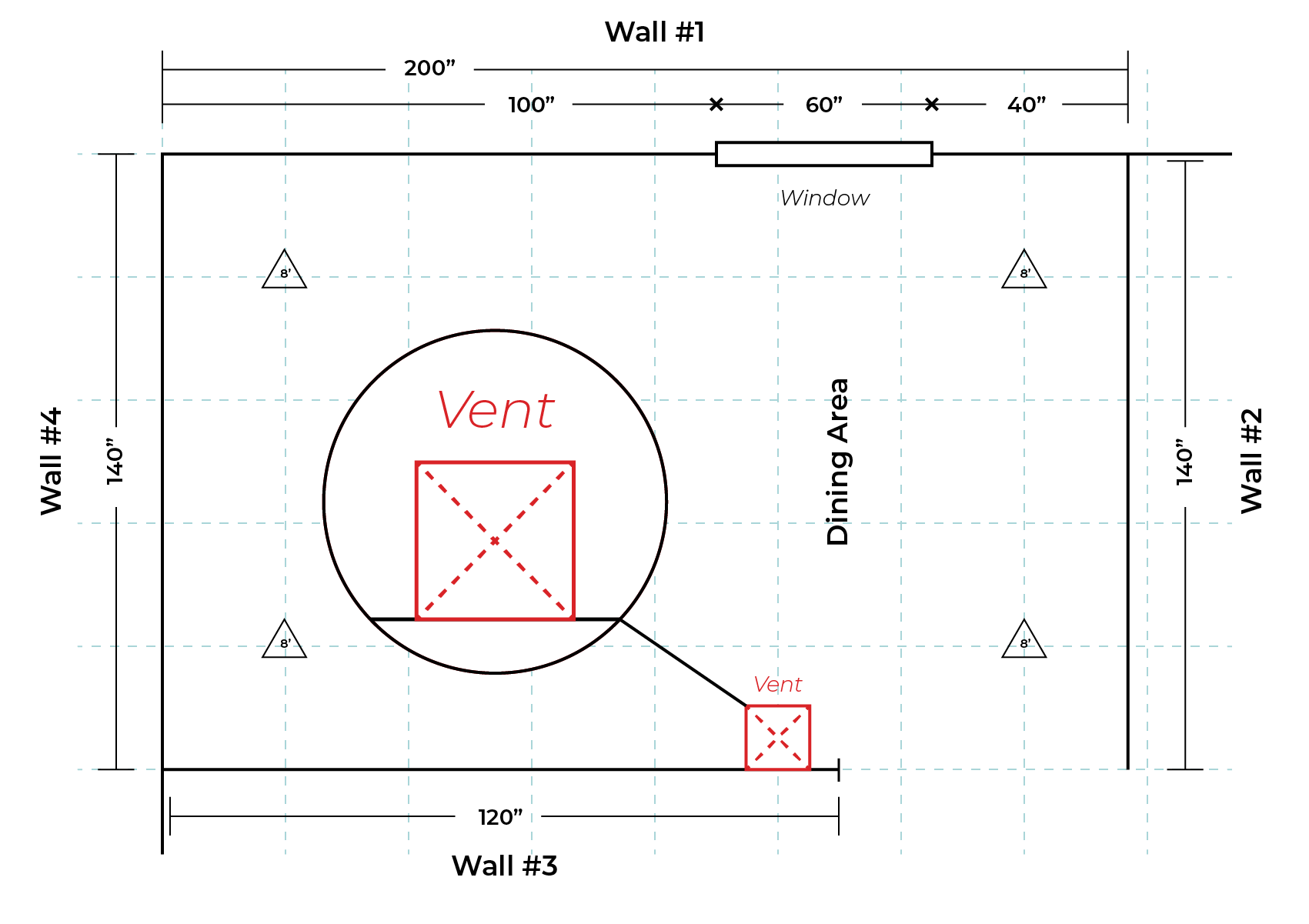
5. Place Appliances and Utilities
Identify all large appliances, fixtures, furniture, and anything else you plan to keep after laying out your new kitchen cabinets. Utilities to make note of include:
- Your water supply
- Any power sources
- Heating or air vents
- Electrical outlets
- Light switches
Mark the location and center point of all your permanent features.
Tip: The center point of appliances is often where the plumbing line or gas line starts.
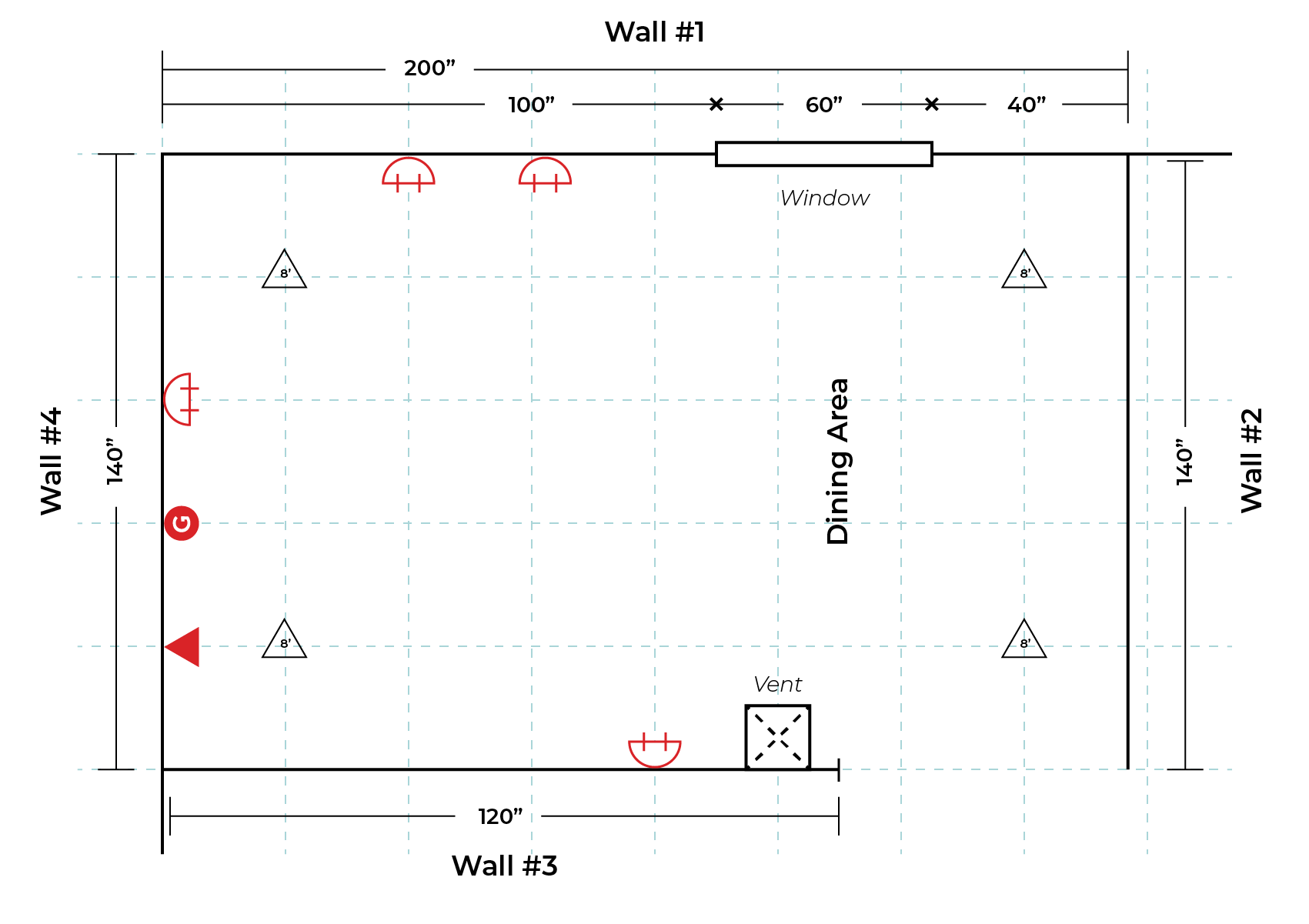
6. Choose Your Kitchen Layout
Your completed floor plan should resemble the below example. Be sure to double-check that your kitchen measurements are accurate and all obstructions and appliances have been included.
Now that you know how much space you have to work with, you can start planning your kitchen layout. The six most popular cabinet configurations to choose from are:
If your kitchen is larger than 10 by 10 feet, you should have enough room to accommodate any of these layouts. However, the best kitchen layout for your space will depend on how you plan to use it. For example, galley kitchens prioritize efficiency in small kitchens, while G-shaped layouts can help close off a kitchen in a large open-concept space.
Before you settle on your new floor plan, consider what issues you have with your current kitchen and how you can address them with a layout tailored to your needs.
Tip: Account for and measure your desired appliances when planning your kitchen layout.
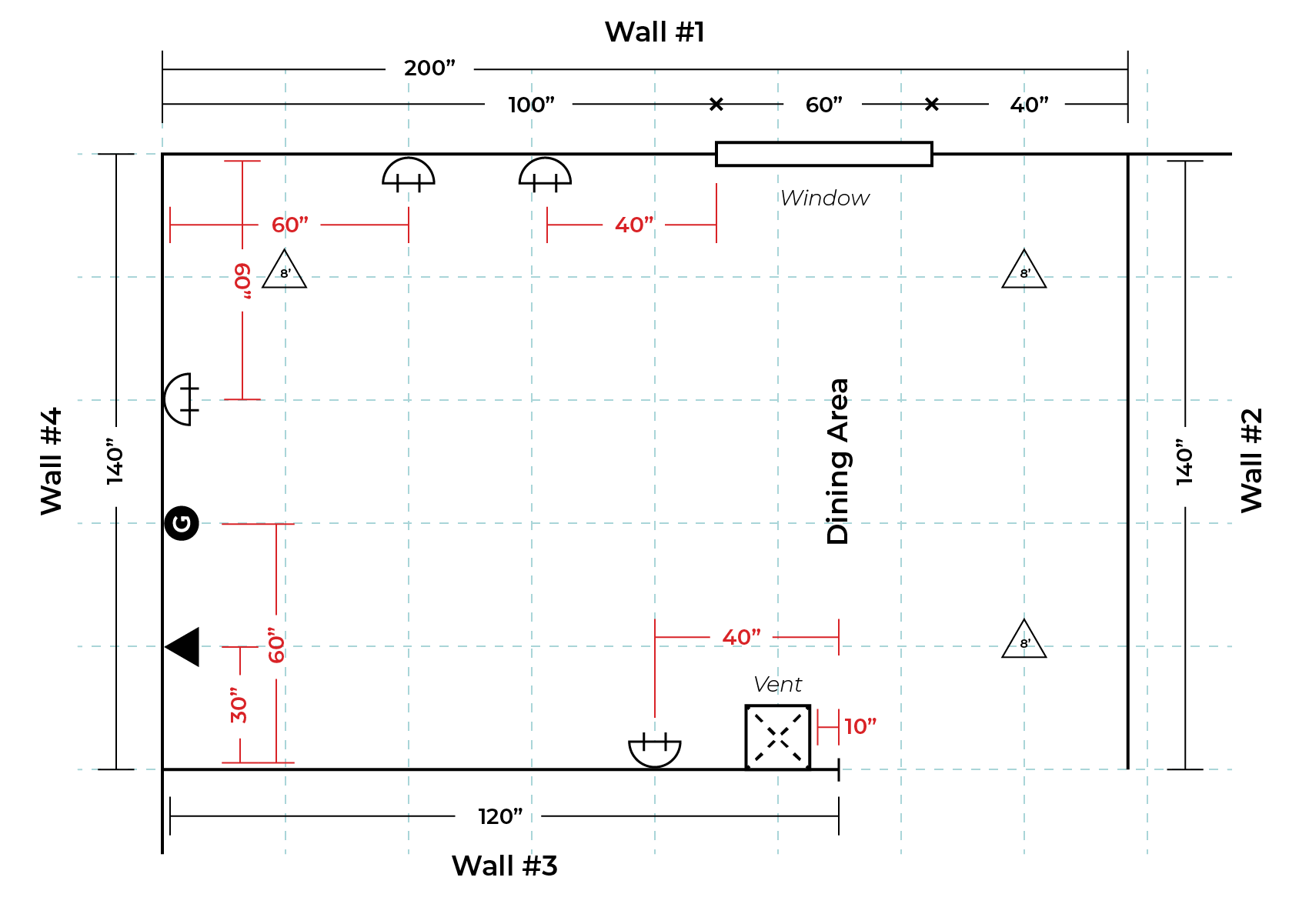
7. Shop for Kitchen Cabinets
Once you have accurate measurements and a plan for your cabinet layout, you can easily narrow down quality cabinets by size, including length, width, and depth.
To find out which cabinets work best in your kitchen, reference our kitchen cabinet size guide. It provides an in-depth look at standard cabinet sizes. The base, wall, or tall cabinets you choose will depend on your storage needs and design preferences.
Start with our selection of stunning kitchen cabinets at wholesale prices.
Tip: Whether you prefer assembled kitchen cabinets or ready-to-assemble kitchen cabinets, there are cabinet door styles that will pair with any kitchen theme.
How To Measure Kitchen Cabinets FAQs
Still stuck on how to measure for your new cabinets? We answered some of the most frequently asked questions about kitchen cabinet measurements to help clear the air.
What are standard cabinet measurements?
If you're planning on purchasing stock kitchen cabinets, standard cabinet measurements for the main three types of kitchen cabinets are as follows:
| Base Kitchen Cabinet | Wall Kitchen Cabinet | Tall Kitchen Cabinet |
|---|---|---|
| Height: 24-34 1/2" Width: 9-42" Depth: 24" |
Height: 30, 36, 42" Width: 12-36" Depth: 12, 24" |
Height: 84, 90, 96" Width: 18 or 24", up to 36" Depth: 12 or 24" |
| Base Kitchen Cabinet |
|---|
| Height: 24-34 1/2" Width: 9-42" Depth: 24" |
| Wall Kitchen Cabinet |
| Height: 30, 36, 42" Width: 12-36" Depth: 12, 24" |
| Tall Kitchen Cabinet |
| Height: 84, 90, 96" Width: 18 or 24", up to 36" Depth: 12 or 24" |
How do you measure a corner cabinet?
Corner cabinets come in many shapes, which means measuring requires a few extra steps to determine the correct size for your layout. Follow these instructions to measure your corner cabinets.
- Measure the length: Start by measuring the back of one side of the cabinet (from back corner to middle edge), then do the same on the other side These measurements are typically the same, but they don't have to be.
- Measure the width: Then, measure the depth from the back corner to the front corner. These measurements should be the same for both.
- Measure the height: Finally, measure from the top to the bottom edge of the cabinet.
Should upper and lower cabinets be the same size?
Upper and lower cabinets are usually not the same size. Because your eyes move side to side instead of up and down when taking in a room, your wall and base cabinets are on different planes. This means trying to get your upper and lower cabinets to "match up" won't have much of an impact stylistically. It's also often functionally impossible due to how appliances are placed within the base cabinets.
When choosing various cabinet sizes for your upper and lower cabinets, focus on functionality for your bottom cabinets and create a balanced arrangement for your wall cabinets.
How many inches should cabinets be from the countertop?
During most kitchen remodels, wall cabinets are hung at least 18 inches above the countertop to provide plenty of workspace for food prep while keeping stored goods and supplies at eye height. Anything higher than 20-22 inches may make storage out of reach. However, older homes usually have upper cabinets just 16 inches above the countertop.
This simple guide will help you learn how to measure your kitchen cabinets with ease and make the design process more enjoyable. Once you're done with measurements and layout planning, you can start gathering design inspiration and piecing together your dream kitchen mood board. Take the time to research all of your kitchen cabinet options and find the perfect door style and size for your space.
If you're looking for free 3D kitchen design advice, our team of professionals can design a carefully customized and functional kitchen layout that revolves around your specific kitchen dimensions, preferences, and needs.









